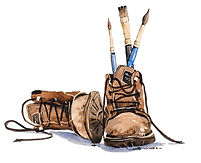The Art of Landscape Painting - The Path to Success
- Olly Pyle
- Oct 13, 2021
- 3 min read

A September Walk From Kingston to Corfe - 72cm x 36cm
If you are in the process of learning how to paint the landscape there are many resources available to you: books, DVDs, free and paid-for online tutorials, blogs, workshops and demonstrations, private tuition. Your early progress is likely to be rapid as you encounter unfamiliar equipment, experiment with new media and gain confidence with different techniques. You move smoothly through the gears, consuming more and more tuition, when suddenly, WHAM!.......you slam, full-speed, into the Brick Wall of Non-Progression. What happened?
The internet-reach available to artists today - some professional, some amateur - has led to an explosion of tutorial-based content being produced for those that are learning to paint; I am indeed a contributor to that. Some of it is free, much of it is paid for and accessible through subscription-based platforms (Skillshare, Patreon et al.) Many would argue that the wide array of teaching content is a good thing, however I hear from you with increasing regularity that this level of choice is not helpful, in fact it may be a hinderance to progress. I agree with you; many online tutors, including those that charge for their 'expertise' could perhaps spend their time more productively learning their craft instead of jumping on board the tuition gravy train. There are many wonderful artists that have provided excellent teaching content over the years through a range of media (Crawshaw, Curtis, Bellamy, Zbukvic, Hoar, Schaller, Evansen, Hilder, Yardley, to name a few of my favourites.) Pay for their expertise.....it's worth it! Sadly, their success has spawned a proliferation of imitators and it is disappointing to see others making money from the originality and skill of others. So, before you part with your money for the next glossy Patreon tutorial ask yourself the following questions: does the work seem similar to another artist's work? Does the artist exhibit and sell their work through recognised and well-established physical galleries? Have they written a book with an international publisher? Is the tutorial providing quality advice, or is it simply a vanity project for the artist to demonstrate their skills? How long have they been painting professionally? Pick one or two though and settle for that, allowing your experience to teach you the rest; I hear from many of you that have taken too many courses (and spent too much money) telling me that the way forward is muddled and the route to success has become blocked with confusion as to the best way to proceed, or that you have veered off down the side road of Painting Style......a nebulous street, if ever there was one.
My use and study of a wide selection of teaching material has revealed a consistent theme: for those that have some experience of painting the landscape there continues to be too much emphasis on the painting and not enough on the landscape. If you are familiar with this blog and have read the 'About' page you will be aware of my perspective on what landscape painting is all about. There is no need to repeat that here, suffice to say that I have put together a short video for those of you who are trying to progress and find success with your landscape painting and I hope that this will enable you to look afresh at the map and find a clear route to your destination. There is no discussion on painting technique, art equipment, or watercolour in general but rather a look at broader ideas and more fundamental concepts. In fact, it is the most important advice I could give you. If you're not a painter but are interested in what motivates a Sussex-based landscape painter, then I hope there's something there for you too........the scenery is ok!
In the video I identify three signposts that will guide you on the path to success as a landscape painter and for ease of reference they are listed here:
Don't paint subjects that don't inspire you
Understand your style and allow it to develop naturally
Remove the obstacles that prevent you from painting outdoors
With regard to the second point on the issue of style, I identify three factors that should define your style as a landscape painter:
How YOU look at the landscape
How YOU feel about the landscape
The techniques YOU prefer using to communicate this
Hope it helps and Happy Painting!





